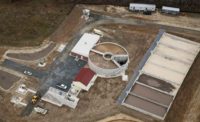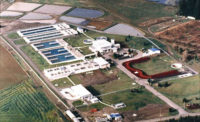“A road header can articulate and move in different directions,” Laws says. “[Hill Country] felt that is more flexible [than a tunnel-boring machine], and because of the relative short tunnel, the firm thought it could get the equipment quicker.”
In addition to the tunnels, High Country will drill out a pump cavity about 450 ft below ground. Water will flow through five large-capacity, deep-shaft vertical-turbine pumps, each in excess of 300 ft. “The long-shaft pumps are on the edge of what is available as far as length and capacity,” Walker says.
The water will be pumped about 1 mile through a 7-ft-dia., steel-lined tunnel, also drilled through rock, about 100 ft below grade to the water treatment plant.
MWH is building the limestone-softening treatment plant into a rocky hillside, while trying not to disturb existing trees. The company will build the plant's control, maintenance and administrative buildings as well as its two clarifiers, dual-media filters and clear well storage units. Some of the clarifiers and storage units are carved into the hill, which is requiring excavation of up to 30 ft.
“Anytime we run into a void, we have to have it evaluated as a potential habitat,” Walker says. That entails halting construction and bringing in a geologist to confirm it could be a habitat for an endangered species. If so, a biologist is brought in to bait for the animal or insect. If a species is found, the team must mitigate the loss by setting aside an equivalent amount of habitat somewhere else. With more than half of the digging complete, no habitats have been uncovered.
Work takes place around bird nesting seasons. Storm drainage water will be treated though filtering in a series of water-quality ponds before draining from the site.
Wherever possible, the plant's water flows by gravity through the different clarification and filtration processes. Walker anticipates the city will save about 13% on energy usage due to the gravity flow.
“They let Mother Nature and gravity do a lot of work for them through the treatment plant,” Laws says.
Carollo designed a batch feed lime system to avoid some of the scaling problems associated with traditional lime-feeds, Walker says. Then carbonic acid will be supplied to the water to recarbonate and stabilize it, which cuts down on the use of carbon dioxide.
Water will flow to an access shaft that connects to 7-ft-wide, steel-lined tunnels to a city-owned reservoir.
Black and Veatch of Overland Park, Kan., is designing the steel-lined clean-water tunnel, which will run between 120 ft and 350 ft underneath the Balcones Canyonland Preserve, to avoid any potential habitats.
Laws anticipates that construction of the 7-mile finished water tunnel will require two tunnel boring machines. But the project has not been bid yet.
“For the first few years of operation, the water will flow from gravity out of this plant,” Meszaros says. “We expect a significant reduction in terms of power use and greenhouse gases.”
The water treatment plant project is scheduled for completion in 2014.
Article toolbar

